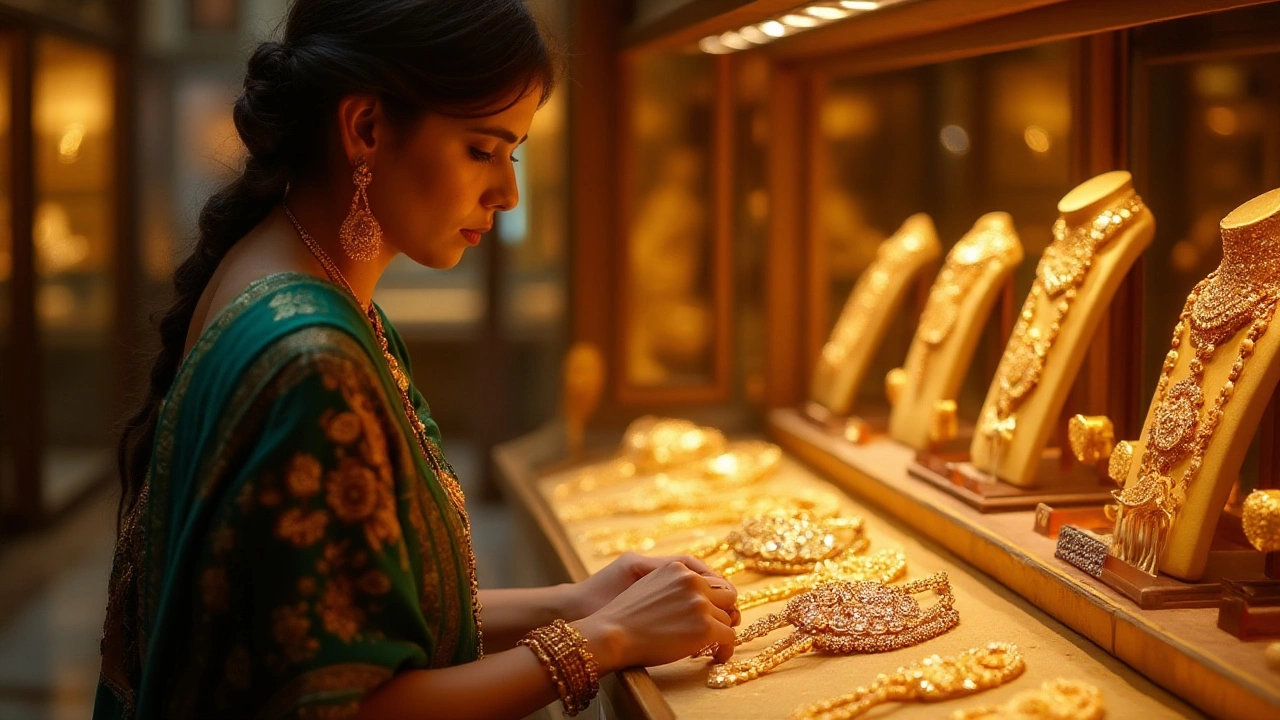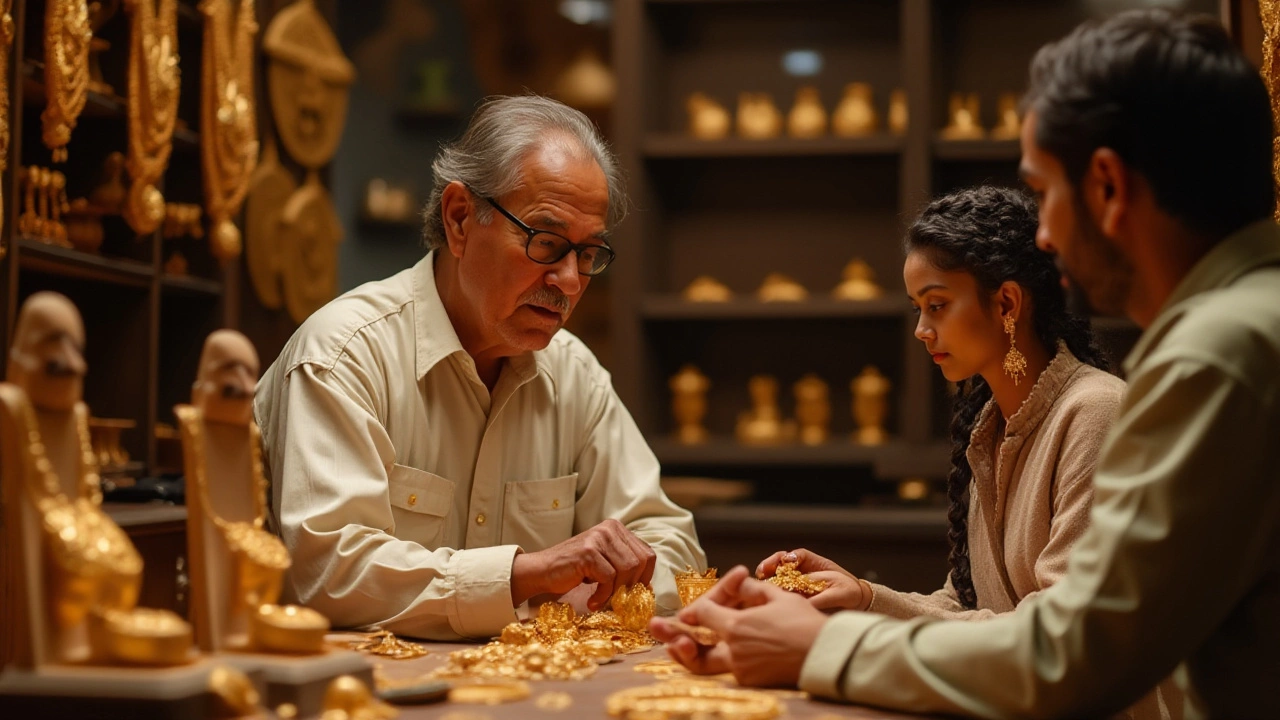
In the sparkling universe of gold jewelry, some brands are emblematic of more than mere luxury; they promise enduring worth. Whether it's the allure of generational wealth or the sheer brilliance of timeless pieces, understanding which brands can lastingly hold their value is crucial for anyone looking to invest.
This exploration takes us through iconic names known for their celebrated craftsmanship and unique designs. Each brand carries its own story, often enhancing its pieces' value beyond the tangible. As we delve into what makes certain brands standout in terms of lasting value, you'll discover not just names but narratives intertwined with artistry and legacy.
Join me on this journey as we uncover insights into selecting jewelry that retains its glow and value, guiding not just your style but your investments into prosperous territory.
- Understanding Jewelry Value Retention
- Top Jewelry Brands with Lasting Value
- Key Factors Influencing Value
- Tips for Smart Jewelry Investments
- Market Trends in Gold Jewelry
- Caring for Your Investment Pieces
Understanding Jewelry Value Retention
When diving into the dazzling world of gold jewelry, one must grasp how certain pieces maintain their worth over the years. Jewelry value retention is a multifaceted concept rooted in several factors, with brand reputation often at the forefront. Jewelry brands renowned for craftsmanship, heritage, and exclusive collections tend to have pieces that appreciate or at least hold their value over time. When considering an investment, the brand's historical performance in the market is crucial. Many brands with a long lineage, often family-owned, leverage their storied past as a testament to their lasting appeal and worth.
Another important factor influencing value retention is the intrinsic quality of the materials used, notably the gold designs. Pure gold, often denoted as 24K, is highly prized but not always practical for everyday wear due to its softness, hence the common use of 18K or 14K gold, balancing durability and value. The addition of other precious elements like diamonds, sapphires, or emeralds can significantly enhance a piece's worth. Limited edition collections or those containing rare gems can skyrocket in value, especially when associated with iconic brand names.
The concept of provenance also plays a significant role. Historically, pieces with notable past ownership or those involved in significant cultural events tend to retain more value. An exquisite example of this is when a piece once owned by royalty or a famous personality comes up for auction, resonating deeply with bidders' imagination and willingness to invest. This connection between a jewelry piece's history and its current financial worth is often emphasized in auction catalogs and by collectors alike.
"The allure of investment in precious jewelry lies not just in its beauty, but also in its historical and emotional resonance." — Lydia Courteille, Renowned Jewelry DesignerAuctions and vintage stores serve as excellent places to observe how provenance and brand prestige jointly impact value. Many investors turn to these venues to seek out pieces with a fascinating backstory or those holding even slight luster of history-induced mystique.
Furthermore, the evolving trends in the market influence a brand's capacity to retain value. While classic designs never fade, contemporary adaptations may occasionally shift value perceptions. Staying abreast of market trends through trusted jewelry exhibitions and fashion forecasts can guide the prescient investor. Notably, seasons and economic climates can also dictate purchasing patterns, thereby affecting resale values. Those deeply involved in the jewelry sector often use resources like price indexes or industry reports to make informed choices about buying or selling high-value items.
In summation, understanding the elements that contribute to jewelry value retention involves a keen appreciation of quality, brand, and historical context. By nurturing this knowledge, investors and enthusiasts alike can ensure their acquisitions not only enrich their personal style but also serve as sound financial choices.
Top Jewelry Brands with Lasting Value
When investing in jewelry brands, discerning buyers often seek those that not only capture the eye but hold their allure over time. In the realm of luxury and elegance, a few notable names have consistently demonstrated their ability to retain value. Let's delve into these exquisite brands that blend aesthetics with investment potential. At the forefront is Cartier, often dubbed as the 'jeweler of kings'. Known for its impeccable craftsmanship and revolutionary designs, Cartier's pieces, like the iconic Love bracelet, continue to fetch high prices at auctions. The brand’s dedication to using quality materials, combined with its storied history, ensures a steady appreciation in value over time. Owners of Cartier collections often find themselves benefiting from both an increase in market valuation and personal milestones—it's a brand that symbolizes both prosperity and heritage.
Another significant player is Tiffany & Co., renowned worldwide for its timeless charm and those signature blue boxes. The American jeweler, with its roots dating back to 1837, has an enduring appeal powered by its legendary designs and the scarcity of its classic collections. Tiffany's engagement rings, for instance, are a testament to their lasting value, offering both an emotional and financial return. As noted by many jewelry experts, Tiffany maintains a meticulous standard of quality control, ensuring that each piece stands the test of time both in durability and significance. An interesting aspect of Tiffany’s approach is their sustained innovation, presenting fresh designs that keep pace with contemporary tastes while retaining their core elegance.
"Jewelry is a way of keeping memories alive, which is why quality over quantity is the imperative when choosing investment pieces," says Patricia Geller, a prominent jewelry historian. Her words echo the sentiment of choosing jewelers with a legacy to safeguard those memories.Similarly, Van Cleef & Arpels holds a respected position in the jewelry world for its poetic and imaginative jewelry compositions. The brand’s pieces are akin to works of art, meticulously crafted using innovative techniques like the Mystery Setting. The rarity and exclusivity of Van Cleef & Arpels jewels elevate their intrinsic and market value. Their adherence to superior craftsmanship and unique storytelling through designs have cemented their status as both collector's items and wise investments.
Moreover, exploring the niche but equally prestigious world of Bvlgari unveils a brand synonymous with boldness and opulence. Bvlgari's Italian heritage shines through in their daring yet elegant designs, recognized globally for striking a balance between tradition and avant-garde styles. The brand’s affair with color and geometry ensures each piece remains distinctive and cherished, often increasing in value as new generations seek the vintage Bvlgari allure. Lastly, we cannot skip mention of Rolex when discussing brands with lasting value. Although primarily known as a watch manufacturer, Rolex's focus on precision and durability translates seamlessly to their jewelry line. The brand’s name alone carries a weight of prestige that bolsters the value of their pieces.
While each of these jewelry brands has its unique charm, they share the common thread of quality, heritage, and inimitable style. Choosing to invest in such brands is akin to owning a piece of history; they are not merely jewelry but stepping stones of culture across generations. Their consistent demand in the resale market and at auctions underscores their place as prudent selections for any serious connoisseur looking to anchor their portfolio in luxury items.

Key Factors Influencing Value
When it comes to assessing the value retention of jewelry, several factors play pivotal roles, each contributing to the financial and sentimental longevity of the pieces. Firstly, the intrinsic value of materials used, particularly gold, is a fundamental aspect. Gold's scarcity and the stability of its market price often provide a firm underpinning for a piece's worth. However, it's not just the material but the purity levels that matter. Higher karat pieces tend to maintain their value better due to the amount of pure gold present, something appreciated both by collectors and investors.
Craftsmanship is the next major pillar in this valuation framework. A brand renowned for its meticulous attention to detail in design and manufacturing can influence a piece’s desirability and ultimate price retention. Artisan techniques, whether they include handcrafting or technologically advanced methods, can add significant value, setting apart a collection from mass-produced items. Such uniqueness not only exudes exclusivity but also escalates historical and artistic significance, often translating to monetary value over time.
Brand heritage and reputation are crucial in the calculus of value retention. Esteemed brands like Cartier, Tiffany & Co., or Bulgari carry a legacy that augments the perceived and real value of their pieces. This enduring recognition is fortified not merely by past achievements but by consistent quality and innovation. According to a recent survey by the Jewelers of America, around 60% of buyers rely on brand reputation as a primary purchase factor, emphasizing its weight in the value equation.
"A brand is more than just a name; it signifies a commitment to an ongoing tradition of excellence," mentioned a notable jewelry historian in a press interview. This resonates deeply with collectors who consider their investments as part of a continuum of luxury and history.
Market trends, although seemingly transient, also have substantive impacts. Shifts in consumer tastes, economic conditions, and geopolitical fluctuations can elevate or diminish the perceived value of certain styles and brands. Gold jewelry is often seen as a haven in uncertain times, with economic upturns often favoring elaborate designs. During volatile periods, simpler, more classic pieces often hold their allure owing to universal appeal and ease of liquidity.
Finally, provenance and rarity weigh heavily in the investment strength of a jewelry piece. The story behind an item, such as past ownership by someone of significance or historical context, often adds to its mystique and allure. Pieces that are part of a limited edition or feature especially rare stones find themselves in a unique niche. Their scarcity and lore can lead to competitive buying dynamics, further ensuring robust value retention.
Tips for Smart Jewelry Investments
Investing in jewelry, particularly jewelry brands that promise value retention, can be both an art and a science. As with any investment, thorough research and understanding are essential to maximize returns and satisfaction. When venturing into the world of luxurious adornments, there are several strategies and considerations that you should keep in mind to ensure a prudent investment of your resources. First and foremost, always begin with education. Dive into the history and reputation of the gold designs that catch your eye. Brands renowned for their exquisite craftsmanship and legacy, like Cartier and Tiffany & Co., often provide a safe harbor for those seeking to see appreciation in both financial and sentimental terms. Immerse yourself in the nuances of hallmarking, certifications, and the purity grading that gold and other metals undergo. This knowledge arms you to discern authentic and valuable pieces from those that may not offer the same potential for appreciation.
Another crucial consideration is the design and demand of the piece. Rare and limited edition designs are more sought after and typically hold their value better over time. Demand plays a vital role - a Rolex or a piece from the Hermès collection often appreciates not only because of its materials but because of the brand's reputation for timeless elegance and exclusivity. It pays to understand what attributes of a piece might drive future consumer interest. The intersection of aesthetic appeal with historical significance or innovative design can markedly affect the piece's future worth. Moreover, watch for collaborations or specific designers associated with the jewelry brand, as these collections might stir a higher value retention due to their unique imprint on the items.
Next, the market trends must be scouted regularly. As global economies shift, so too do the prices of precious metals and gemstones. For example, when gold prices surge due to economic factors, the intrinsic value of your jewelry increases, revealing a profitable side of investing in such commodities. Keeping an eye on auction results can also offer insights into current trends and values. Sites like Sotheby's and Christie’s often list realized prices for similar items, setting considerable benchmarks for jewelry worth evaluation. With a keen eye on the market, you can make educated decisions about the opportune times to buy or sell.
Jewelry care significantly influences the longevity and hence the value of investments. Proper storage, cleaning, and maintenance ensure that your pieces remain in pristine condition, fending off depreciation due to neglect. Purchase a soft-lined jewelry box, and keep it in a place with controlled temperature and humidity to prevent tarnishing or damage. Delicate pieces might require professional cleaning services every few years, but routine maintenance, like gently wiping after wear, goes a long way in preserving luster and value. Engaging with services like jewelry assessments or appraisals periodically will keep you informed about the current value and help you with documentation in case of insurance or selling needs.
"Jewelry is more than an adornment; it is an investment intertwined with emotion and tradition." – A commonly shared sentiment by many industry experts
Understanding taxation and insurance are the final pillars of smart investments in luxury goods like jewelry. Some countries offer a tax-free regime for precious metals and jewelry under specific circumstances, giving room to plan your investments smartly. Additionally, having well-structured insurance to protect these valuable assets will assure peace of mind. Evaluation and insurance documents not only serve as a precaution but also add procedural legitimacy to your ownership, potentially facilitating smoother transactions in the event of resale. By considering these elements, you can turn your passion for jewelry into a versatile and reliable investment portfolio.

Market Trends in Gold Jewelry
Emerging trends in the gold jewelry market continue to shape how pieces are valued and perceived worldwide. Over recent years, there's been a marked shift towards personalized and unique designs, which cater to individual tastes and stand out from mass-produced items. These bespoke pieces not only offer personal meaning but have also driven increased demand in limited editions, often leading to a higher retention of value. This trend is particularly evident among millennials and Gen Z, who seek jewelry that reflects their identity and values.
One significant trend is the move toward sustainable and ethically sourced jewelry. Brands that prioritize environmental and social responsibility often see a competitive advantage. With consumers increasingly informed about the impacts of mining and production, companies that commit to transparency in their sourcing and manufacturing processes can appeal strongly to conscientious buyers. This emphasis on ethical practices can enhance a brand's reputation and thus its long-term value.
The luxury segment continues to dominate the high-value market, with brands like Cartier, Tiffany & Co., and Bvlgari setting high standards for quality and craftsmanship. These brands have stood the test of time due to their strategic emphasis on maintaining exclusivity through meticulously crafted pieces. Such brands not only retain their value but often see appreciation in price over time. According to a JCK report, the demand for luxury jewelry increased by 12% in 2023, attributed largely to growing international markets and affluent consumers investing in high-worth items.
"Gold jewelry purchases have become intertwined with digital innovation and consumer engagement," noted a recent report from the World Gold Council.Tech-savvy consumers are driving brands to expand their digital presence, leading to a surge in online jewelry sales. This digital shift has democratized access to high-quality jewelry, allowing buyers to shop and invest in gold pieces from the comfort of their homes while also accessing a wealth of information about value retention and trends.
Many jewelers are experimenting with new technologies that blend traditional craftsmanship with modern innovation. For instance, 3D printing and AI-led design iterations have allowed for greater personalization and sophistication in gold jewelry designs. These technologies enable brands to offer intricate designs that were previously unfeasible, appealing to a new generation of jewelry enthusiasts.
Finally, there's an increasing interest in vintage and estate pieces, fueled by nostalgia and the timeless appeal of classic designs. Vintage jewelry not only maintains a historical narrative but also often comes with a uniqueness that modern items can't replicate. Collectors and investors keen on such pieces find themselves in a niche yet rewarding market. Auctions have become a popular platform for buying and selling high-value vintage items, where bidders appreciate both the craftsmanship and the historical significance of these jewelry pieces.
Caring for Your Investment Pieces
Maintaining the luster and value of your treasure trove of jewelry involves more than just admiring them from afar. Proper care and attention are essential to preserving these exquisite items over time, especially if they are significant financial and emotional investments. Start by understanding the particular needs of your jewelry based on the metals and gemstones involved. For instance, gold, known for its durability and rost-resistant properties, still requires regular cleaning to prevent tarnish and scratches. This applies to both simple gold bands and those encrusted with precious stones, where dirt can accumulate, dulling their natural sparkle.
Environmental factors can significantly affect the longevity of your pieces. Humidity levels, exposure to sunlight, and even the chemicals in perfumes and cosmetics can accelerate the degradation of both metals and stones. Thus, storing your gold designs in a temperature-controlled environment and away from direct sunlight is a precaution worth taking. Even the simple act of putting on jewelry after your grooming routine can prevent unwanted chemical interactions. As the iconic jeweler Tiffany & Co. advises, "Clean your jewelry regularly using mild soap and warm water. Rinse thoroughly, and dry with a soft cloth." This practice not only maintains the shine but also allows regular inspection of settings and clasps, ensuring they remain secure.
Regular Maintenance and Inspections
Even with careful storage and handling, engaging professional services for jewelry cleaning and inspection ensures the longevity of your pieces. It is akin to servicing an upscale car – regular check-ups can prevent potential problems from escalating. Jewelers can provide ultrasonic cleaning or steam cleansing to remove stubborn residues that at-home methods might miss. They also examine the strength of prongs and clasps, crucial for the prevention of losing valuable stones. Many top jewelry brands offer complimentary inspections periodically, a service well worth availing.
Investing in neutral pH cleaning solutions recommended by experts is another strategy. These solutions are specifically formulated to cleanse without corrosive effects on metals or gems. Consider a biannual schedule for deep cleaning your most worn pieces, whereas those reserved for special occasions may only need annual attention. For instance, given the enduring nature of brands like Cartier and Bulgari, these practices help your pieces from these makers in retaining worth and splendor over the decades.
Mindful Wearing Practices
The manner in which you wear your jewelry also affects its long-term condition. Avoid wearing elegant pieces during rigorous activities like sports or while using harsh cleaning chemicals. Even everyday tasks, such as washing dishes or gardening, can expose jewelry to harm if protective measures aren't taken. Investing in jewel-specific fabric-lined cases ensures safe travel for your pieces, protecting against scratches and impacts, preserving their immaculate finish. If you plan to wear layered jewelry, be mindful of tangling, as chains can easily break when intertwined.
"Jewelry should never be submerged in water for long periods, such as a swimming pool, to avoid chlorine damage," suggests renowned jeweler Harry Winston.
Developing these habits helps keep your investments pristine, a balance of style and pragmatism ensuring your valuables maintain their allure through time. Adopting these measures not only provides peace of mind but affirms that your jewelry's brilliance today can easily be shared as heirlooms passed down tomorrow. Each piece continues its journey unscathed, echoing the high standard of craftsmanship from the atelier that created it.


